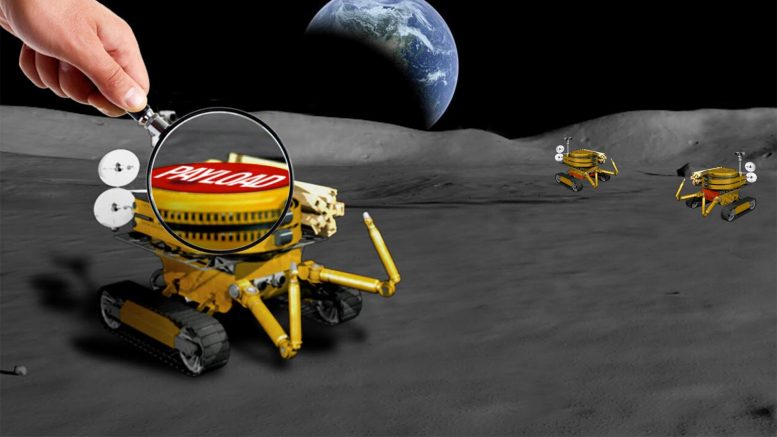
The JPL-led challenge is seeking tiny payloads no larger than a bar of soap for a miniaturized Moon rover. Credit: NASA
The winners for the JPL-led “Honey, I Shrunk the NASA Payload” challenge have been announced, and the miniature robotic designs could help the agency explore the Moon.
NASA’s next giant leap may be aided by tiny lunar robots. These miniature robots would help scout the lunar surface, collecting key information about the Moon, its resources, and the environment. Such data would be helpful for the agency’s future lunar endeavors and NASA’s Artemis program.
In April, NASA’s Jet Propulsion Laboratory in Southern California ran a public prize competition for miniature payload designs for future Moon missions. The “Honey, I Shrunk the NASA Payload” challenge garnered the interest of hundreds of innovators. Now, the winners have been announced.
“The ideas generated by the community were outstanding,” said Sabah Bux, a technologist at JPL. “These designs could help NASA sustain a human presence on the Moon and enable new science.”
Existing payloads are often big, heavy, and require a lot of power. Tiny payloads allow for the development of technologies that can do more prospecting and science on smaller, more mobile platforms. This challenge sought designs for payloads not much larger than a bar of soap – 3.9 inches by 3.9 inches by 1.9 inches (10 centimeters by 10 centimeters by 5 centimeters) – and weighing no more than 0.8 pounds (0.4 kilograms).
Submissions were divided among two categories: lunar resource potential and lunar environment. A total of $160,000 in prizes was awarded.
Category 1: Lunar Resource Potential
First Prize: $30,000
- Puli Lunar Water Snooper by Puli Space Technologies Team
Second Prize: $15,000
- Permittivity Analysis of Regolith Using SansEC by Nova Rover Payload Team
- KSat Stuttgart e.V. MICU 3D Mineral Seeker by KSat Team
- M-EL VIS, Locating and Mapping Lunar Volatiles by Curtis Purrington
Third Prize: $5,000
- Adaptable Science Box: Magnetometer+Rad Detector by Space Initiatives Inc
- LAMPER by Amin Aminiaei
- Moon Soil Resources From Seismic Waves by Drive Me Through the Moon Team
- Raman-based Mineral Classification Payload (RMCP) by Top Raman NASA Payload Team
- M.E.G.A.M.A.N. by Big Brain, Little Payload Team
Honorable Mentions
- Miniaturized Payload for Regolith Characterization by Padua Team
- Lunar Vision. Coloring the Moon! by Team Stardust
- RICO by RICO Team
Category 2: Lunar Environment
First Prize: $30,000
- Sun Slicer – Miniaturized XRAY Spectrometer by Team Sun Slicer
Second Prize: $15,000
- LEA (Lunar surface Energetic neutrals Analyzer) by Bhardwaj Shastri
Third Prize: $5,000
- Novel Fibber Bragg Grating Seismometer by John Draganov’s team
- Lunar Radiation Characterization by Christian Haughwout
- Laser Based Dust Detector for the Lunar Surface by Ryan Smith
For more information about the winners of this challenge, visit:
www.herox.com/NASApayload/131-meet-the-winners
You can also participate in a moderated discussion with the NASA challenge team, hosted by HeroX, on August 6 at 1 p.m. EDT (10 a.m. PDT). Register here.
The challenge is expected to be followed by new competitions to prototype, test, and deliver the winning ideas. It is also intended to generate a maturation pipeline of next-generation instruments, sensors, technologies, and experiments for near-term lunar exploration.
The challenge was funded by NASA’s Lunar Surface Innovation Initiative within the agency’s Space Technology Mission Directorate (STMD). The initiative champions technologies needed to live on and explore the Moon. The NASA Tournament Lab, part of STMD’s Prizes and Challenges program, managed the challenge. The program supports the use of public competitions and crowdsourcing as tools to advance NASA R&D and other mission needs.
Learn more about opportunities to participate in your space program via NASA prizes and challenges:
Artemis includes sending a suite of new science instruments and technology demonstrations to study the Moon, landing the first woman and next man on the lunar surface by 2024, and establishing a sustained presence by 2028. The agency will leverage its Artemis experience and technologies to prepare for the next giant leap – sending astronauts to Mars.


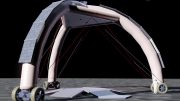
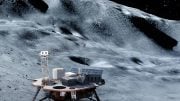

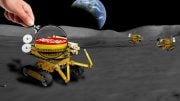

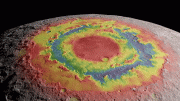

Be the first to comment on "NASA Mini Payload Challenge Winners Announced – “Honey, I Shrunk the NASA Payload”"